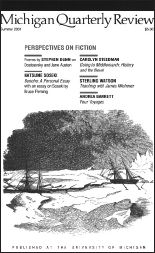Differentiating kinds of sources
Page contents:
Sources can include data from interviews and surveys, books and articles in print and online, websites, films, video and audio content, images, and more.
Primary and secondary sources
Primary sources provide firsthand knowledge; secondary sources report on or analyze the research of others. Primary sources are basic sources of raw information, including your own field research; films, works of art, or other objects you examine; literary works you read; and eyewitness accounts, photographs, news reports, and historical documents such as letters and speeches.
Secondary sources are descriptions or interpretations of primary sources, such as researchers’ reports, reviews, biographies, and encyclopedia articles.
Often what constitutes a primary or secondary source depends on the purpose of your research. A critic’s review of a film, for instance, serves as a secondary source if you are writing about the film but as a primary source if you are studying the critic’s writing.
Most research projects draw on both primary and secondary sources. For example, a research-
Scholarly and popular sources
Although nonacademic sources such as magazines and personal websites can help you get started on a research project, many college assignments call for you to depend more heavily on authorities in a field, whose work generally appears in scholarly journals in print or online.
Scholarly

|
Popular
Reproduced with permission. Copyright © 2016 Scientific American, a division of Nature America, Inc. All rights reserved.

|
|
Title often contains the word Journal Available mainly through libraries and library databases Print periodicals have matte (not glossy) pages with few commercial advertisements Little or no color; few illustrations Authors identified with academic credentials |
Journal usually does not appear in title Available at newsstands or from a home Internet connection Print periodicals have glossy pages with many advertisements Full color; many illustrations Authors are usually journalists or reporters hired by the publication, not academics or experts |
|
Summary or abstract appears before beginning of article; articles are fairly long Articles cite sources and provide bibliographies Examples: Public Opinion Research Quarterly, Journal of the American Medical Association, Ecology and Society |
No summary or abstract; articles are fairly short Articles may include quotations but do not cite sources or provide bibliographies Examples: Scientific American, The New Yorker, Salon |
Many (but not all) scholarly sources are peer reviewed, which means that experts in the discipline read and approve every article before it is published in the journal.
Older and more current sources
Most projects can benefit from both older, historical sources and more current ones. Some older sources are classics in their fields, essential for understanding the scholarship that follows them. Others are simply dated, though even these works can be useful to researchers who want to see what people wrote and read about a topic in the past. Depending on your purpose, you may rely primarily on recent sources (for example, if you are writing about a new scientific discovery), primarily on historical sources (for instance, if your project discusses a nineteenth-